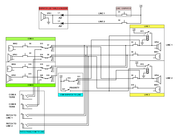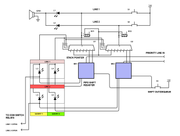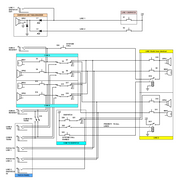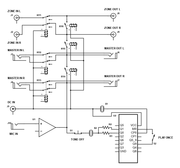efinque
Well-known member
- Joined
- Jan 3, 2018
- Messages
- 393
Sup GDIY,
some 15 years ago in school I built a battery-operated 2-way intercom with a master&slave unit.. I was thinking about it the other day as it had a call function etc so I began designing my own as a kind of a shot in the dark.

Here's what it looks like.. it has dispatch from sub-stations to com and vice versa, emergency dispatch from com to line(s), com establish via rotary switch, push to tx/rx and a com to line patch panel.. am I missing some functionality here other than opamps etc?
Installed in real life it'd need very long, multiple runs of cable which is it's main limitation. S1-3, S2-4, S7-8 and S11-12 are ganged switches btw.
Physically the center/com unit would have a mic/speaker, com select switch, tx/rx, dispatch on/select, priority switch and a patch panel for connecting two sub stations. The sub station would consist of a tx/rx switch, dispatch and mic/speaker.
The problem I'm starting to see here is the patching which "reserves" the com unit momentarily, to work this around the patch tx/rx would need it's own switch prior the com select I guess, and an insert for patching the com mic/speaker to the established line.
Any thoughts?
-ef
EDIT : if one was to automate it it'd need a relay board or something so it breaks the connection between two lines set by the operator.
EDIT 2 : it could use a button to relay all the line speakers for system/priority announcements. It doesn't have call handling or queueing (I was thinking a FIFO type shift register where the dispatch shifts the line number to a table of leds indicating the caller and the place in the queue and they're shifted out by the handler upon connecting) so it requires an operator. I'll post an updated schematic later..
some 15 years ago in school I built a battery-operated 2-way intercom with a master&slave unit.. I was thinking about it the other day as it had a call function etc so I began designing my own as a kind of a shot in the dark.

Here's what it looks like.. it has dispatch from sub-stations to com and vice versa, emergency dispatch from com to line(s), com establish via rotary switch, push to tx/rx and a com to line patch panel.. am I missing some functionality here other than opamps etc?
Installed in real life it'd need very long, multiple runs of cable which is it's main limitation. S1-3, S2-4, S7-8 and S11-12 are ganged switches btw.
Physically the center/com unit would have a mic/speaker, com select switch, tx/rx, dispatch on/select, priority switch and a patch panel for connecting two sub stations. The sub station would consist of a tx/rx switch, dispatch and mic/speaker.
The problem I'm starting to see here is the patching which "reserves" the com unit momentarily, to work this around the patch tx/rx would need it's own switch prior the com select I guess, and an insert for patching the com mic/speaker to the established line.
Any thoughts?
-ef
EDIT : if one was to automate it it'd need a relay board or something so it breaks the connection between two lines set by the operator.
EDIT 2 : it could use a button to relay all the line speakers for system/priority announcements. It doesn't have call handling or queueing (I was thinking a FIFO type shift register where the dispatch shifts the line number to a table of leds indicating the caller and the place in the queue and they're shifted out by the handler upon connecting) so it requires an operator. I'll post an updated schematic later..
















